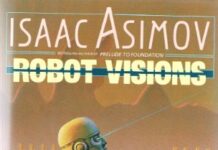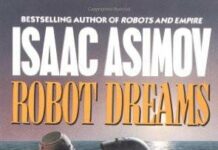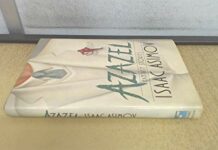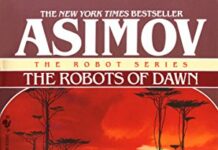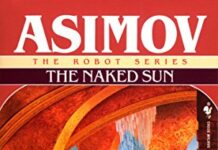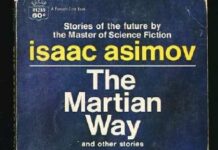
Ebook Info
- Published: 2004
- Number of pages: 320 pages
- Format: EPUB
- File Size: 0.22 MB
- Authors: Isaac Asimov
Description
The second novel in Isaac Asimov’s classic science-fiction masterpiece, the Foundation seriesTHE EPIC SAGA THAT INSPIRED THE APPLE TV+ SERIES FOUNDATIONLed by its founding father, the psychohistorian Hari Seldon, and utilizing science and technology, the Foundation survived the greed and barbarism of its neighboring warrior-planets. Now cleverness and courage may not be enough. For the Empire—the mightiest force in the Galaxy—is even more dangerous in its death throes. Even worse, a mysterious entity called the Mule has appeared with powers beyond anything humanly conceivable. Who—or what—is the Mule? And how is humanity to defend itself against this invulnerable avatar of annihilation? Filled with nail-biting suspense, nonstop action, and cutting-edge speculation, Foundation and Empire is the story of humanity’s perpetual struggle against the darkness that forever threatens to overwhelm the light—and of how the courage of even a determined few can make all the difference in the universe.
User’s Reviews
Reviews from Amazon users which were colected at the time this book was published on the website:
⭐This is reread. Some of the tech is now very dated. But it is an enjoyable story.
⭐I’m reading the original Foundation trilogy for the 3rd (or maybe 4th?) time, but the first time in at least 20 years. I’ve got a few points to note, in no particular order:1) Old science fiction tells us so much about the past. The things they never thought would change — cigarettes, newspapers, women in the home, microfilm (!) — show us just how prominent our blind spots can be. And the things they didn’t even dream of (most obviously, the internet, but also race and s*xual relations, cell phones, etc.) tell us just how far and how quickly things change.2) Reading it the first (and 2nd) time through, the young ambitious Federation reminded me of the USA — young, resourceful, growing, upstarts. Now, I read it and the dying, corrupt, Empire reminds me of the USA. I’m not sure if this is my getting older (and pessimistic) or whether the times have changed so much since the 40s and 50s. In any case, there’s an optimism in these books (like a lot of old sci-fi) that has long since passed out of (American?) pop culture.3) There’s a funny disconnect between 1 and 2 — and I’m not sure where it is. So much has improved for so many, and yet the future now seems more scary than ever. Part of me reads this as escapist fun, part of me reads it to try to exercise my powers of optimism. (Without starting any arguments about current politics or which apocalyptic future I fear, let me say that I grew up in the Cold War with a very real fear of dying in a nuclear war — the only bright side being that living in DC meant that I’d be incinerated instantly, and not suffer a lingering post-war death. Are any our current fears more likely or more catastrophic than that?)4) There is little emotional depth in the Foundation. We don’t get outsiders or brooding introspection, we learn about the characters through what they do. It reminds me a bit of the Icelandic sagas I just finished reading: lots of who did what, over how many generations — and while there’s little internal monologueing, you see that actions give insight into character. Perhaps it’s our blind spot now to to think that how things feel to you is the most important thing in the world.5) The Mule seems — to my eyes — a portent of 1960’s. Without giving any spoilers, suddenly everyone sees that people’s feelings are far more important and disruptive than any technology. (And the visi sonor seems so close to a depiction of an LSD trip that it makes me wonder what was going on in Asimov’s personal life around this time!)In conclusion, I encourage any old fans to pick up and re-read the series: you’ll get something different out of it than the last time.
⭐I think Asimov started to struggle more with story-line here. Some of the introduced characters are interesting, but too much of it is feeling contrived now.
⭐I am a big fan of Isaac Asimov, but this second novel seems to lack something to me. I enjoyed it, but it was transparent what the ending is. It lacked a better twist.
⭐Foundation and Empire is the second of the original Foundation trilogy written in the 1950s. The first book is Foundation and the last is Second Foundation. I enjoyed Foundation but I liked F&E quite a bit more! Foundation consists of five disconnected short stories, too short for adequate development of the settings or characters. F&E is much more focused, containing only two stories, the second of which really impressed me.A quick refresher on the background: The psychohistorian Hari Seldon was able to mathematically foresee the future of human society in the Milky Way. It wasn’t pretty. Socio-economic forces were to cause the total collapse of the Trantorian Empire and lead to 30,000 years of anarchy and barbarism before a new empire restored peace and order. However, Seldon saw an “alternate path” that could reduce the duration of the Dark Ages to a single millennium. He established two societies (called Foundations) to bring this change about.In Foundation, we learn how the fledgling First Foundation established itself after Seldon’s death and how it grew powerful. In F&E, Seldon is long dead and the First Foundation faces much more serious threats: a war with the dying but still powerful Trantorian Empire and a war with a mutant leader called The Mule who possesses incredible powers. The part about the war with the Empire is a straightforward narrative with a couple interesting twists. The second part about The Mule takes place a few decades later and is written in the style of a mystery, sort of like the first two Robot novels.Since The Mule is an individual of extraordinary power, Seldon’s psychohistorical predictions for the First Foundation are in jeopardy because they deal only with masses of people and large scale socio-economic forces. Hence the second part is a more exciting read. 🙂 Also, until the end of the second part the Second Foundation is a mysterious society on the other side of the Galaxy about whom we know next to nothing. Although I guessed the nature of The Mule’s powers, I did not guess his identity and it was a great surprise for me when it was revealed at the end. The events of the last two chapters are stunning and really make you want to rip into the third book. Yet F&E doesn’t end on a cliffhanger and is quite satisfying in and of itself. This unique blend is a testament to Asimov’s genius as an author. Also, you’ll learn why the mutant calls himself The Mule and it’s quite enlightening!With novels written later, Asimov tied together three series into one huge one! I recommend reading the entire 14-book series in the following order: the four Robot novels, the three Empire novels, and the seven Foundation novels (the original trilogy plus two prequels and two sequels). So far I’ve yet to read the last three Foundation books (Second Foundation, Foundation’s Edge, Foundation and Earth), but so far most have been excellent and all have been well above average.
⭐In the first book of the Foundation series, Azimov tells the story of the Foundation, established by psychohistorian Hari Seldon. Seldon’s laws of psychohistory allowed him to work out the likely path of galactic history for centuries to come, and the Foundation’s task was to nudge that history toward reestablishing order instead of a long, violent interregnum as the Empire collapsed.Azimov recognized that following the path of a historian’s predictions lacked dramatic tension, at least once the first book had established Seldon’s prescience. The second half of the this book introduces a person that Seldon could not foresee, the Mule. The Mule sees himself as guiding the galaxy on an equally valid path toward legitimate order. Of course, some want to stop him, either to restore the Foundation or to put history on its proper path.As in the first book, almost all of the “action” takes place through set-piece conversations. This makes the series surprisingly theatrical – though I suspect the forthcoming television series will deliver blockbuster action instead.If you liked Foundation, you’ll like this book and the third, Second Foundation. Asimov’s Foundation books became more irregular in quality after the original trilogy.
⭐I first read the Foundation trilogy back in the ‘60’s and as a 16 year old lad I was amazed by how brilliant it was, this galaxy wide Empire story gripped my imagination like no other had. Over the years I have often thought about it and how fantastic and futuristic the story was with all its plots, characters and twists and turns, surely the greatest SF book of all time, and I have held that opinion for the last 60 years.I decided it was time to revisit the Foundation series and ordered the trilogy and looked forward to being enthralled by the writings of Asimov once again.Oh dear! This is definitely not how I remembered it at all, the story seems so very silly now, planets that had lost nuclear power are taught to treat it as a religion, run by the Priesthood of the First Foundation when they reintroduce it. How very unlikely. Simply because they had lost the skilled workforce and knowledge necessary to build nuclear power plants and atomic devices certainly does not mean they will regard it in awe as a mysterious religious force of some weird priesthood when reintroduced. No, not even remotely plausible, even when trying to go along with it for the sake of the story.The wonderful power of Seldon’s psychohistory in predicting the future path the Foundation would take over the next thousand years, while so believable at the time, now doesn’t make sense at all, just not realistic, Chaos Theory changed all that!I should have left Foundation where I found it, back in the past, it has come as a great disappointment to discover it isn’t the wonderful masterpiece I once believed it was. I really regret reading it again as an older, and perhaps wiser, but definitely more cynical, grumpy old grandfather.Never go back, things are never as you remembered them in your youth.
⭐SPOILER FREEThe second entry to Isaac Asimov‘s Foundation Trilogy had a slow start but soon picked up. I found that after the introduction of Foundation, the plot of Foundation and Empire was far more concise.I love a good puzzle, and Isaac Asimov delivers more than one. Who is the Mule and what does he want? What is the Second Foundation, where is it, and why is there one there?I won’t go into spoilers in this bit, but I will say that the answers to those questions are not only satisfying but exciting, and they had me tearing through the second half of this science fiction book. Obviously, not all questions are answered, but who doesn’t like to speculate?This was a great sequel – I hope the final entry of the trilogy lives up to the promises given in this book.SPOILER SECTION BELOW“The General”Despite the attack on the Foundation from the Galactic Empire, I found this part of Foundation and Empire to be quite slow. It promises action and we are left with political manoeuvres. Not that I don’t like politically driven plotlines, but that’s not what I was promised!With the Empire calling off its attack, the members of the Foundation work to figure out what they were supposed to do. This does hint at something going wrong with Hari Seldon’s psychohistory, as he makes no mention of this event.“The Mule”This part was incredible and is the main reason anyone who finds the first part difficult to get though should read on.The Mule himself is an interesting villain due to the powers he seems to have, however all he seems to want is power for power’s sake, and that sort of ruins him for me. Perhaps we will see more of him in the third entry that will explain his motivations.The ending with the reveal of the Second Foundation was so good that I couldn’t stop reading. I think it was because I’d forgotten completely about this second Foundation (from the first book), but also it might have been Hari Seldon’s plan all along.Distract the villain with the Foundation to allow the second Foundation to flourish and prepare in time for his attack. I have so many questions and that’s what SF is all about!
⭐The label “The greatest science fiction series of all time” is definitely not hyperbole. So don’t hesitate, unless you are expecting the book to have the feel of having been written today rather than in the 1950s, in which case you will no doubt find things to take issue with.And do be aware that the new TV series from Apple is very different from the books. Happily, this second book of the original “Foundation” series does not (unlike “Foundation”) use of an image from the series on the cover, so that should avoid giving the impression the book will reflect what’s on screen. (From what I’ve seen so far, the books are much better.)
⭐When it comes to Sci Fi, Assimov, in my opinion was a master. Have read all his books in the past, and they’re still as good as ever, even though the tech’ used is a bit dated.
⭐I first read this as a teenager, it hasn’t lost its any of its attraction, still a really good read.
Keywords
Free Download Foundation and Empire in EPUB format
Foundation and Empire EPUB Free Download
Download Foundation and Empire 2004 EPUB Free
Foundation and Empire 2004 EPUB Free Download
Download Foundation and Empire EPUB
Free Download Ebook Foundation and Empire
